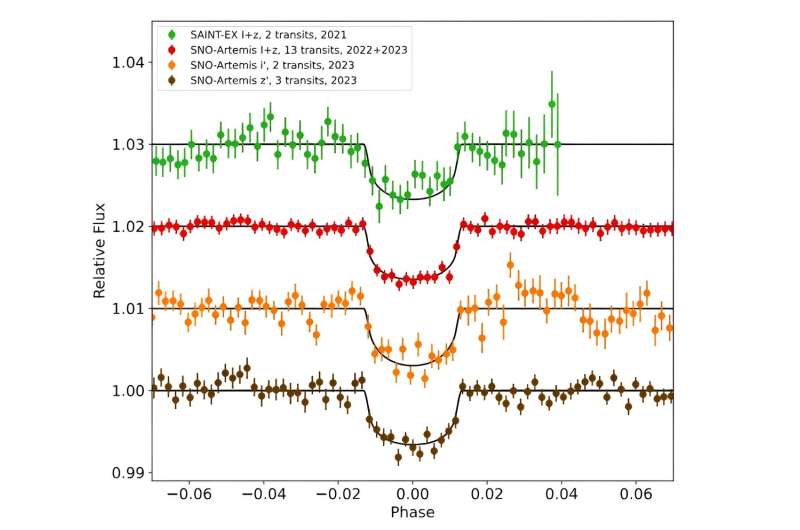
An international team of astronomers reports the discovery of a new Earth-sized exoplanet that orbits an ultracool dwarf star located just 54.6 light years away. The newfound alien world, designated SPECULOOS-3 b, is slightly smaller but much hotter than our planet. The finding was reported in a paper published May 15 in the journal Nature Astronomy.
The Search for Planets EClipsing ULtra-cOOl Stars (SPECULOOS) project aims to find potentially habitable exoplanets around some of the smallest and coldest stars of the solar neighborhood. It employs a network of six robotic 1-m-aperture telescopes: the four telescopes of the SPECULOOS-South Observatory (SSO) in Chile, Artemis, the first telescope of the SPECULOOS-North Observatory (SNO) in Tenerife, and the SAINT-EX telescope in San Pedro Martir Observatory in Mexico.
One of the stars observed as part of the SPECULOOS program is SPECULOOS-3 (also known as LSPM J2049+3336)—an ultracool dwarf of spectral type M6.5, about eight-times smaller and 10-times less massive than the sun. The star is estimated to be 6.6 billion years old and has an effective temperature of 2,800 K.
A group of astronomers led by Michaël Gillon of the University of Liège in Belgium has recently detected a transit-like signal in the light curves of SPECULOOS-3. Follow-up observations of this star found that this signal is caused by an Earth-sized extrasolar planet.
“We present the SPECULOOS project’s detection of an Earth-sized planet in a 17-hour orbit around an ultracool dwarf of M6.5 spectral type located 16.8 parsecs away,” the researchers wrote in the paper.
According to the paper, SPECULOOS-3 b has a radius of approximately 0.977 Earth radii and orbits its host star every 17.28 hours. The planet’s equilibrium temperature was estimated to be about 553 K.
The mass and therefore the composition of SPECULOOS-3 b remains unknown. However, the astronomers assume that this planet has a rocky composition for such a small planet on such a short orbit to have maintained a substantial envelope of hydrogen. Moreover, they add that all currently-known Earth-sized planets in the NASA exoplanet archive have masses implying rocky compositions.
The researchers note that if SPECULOOS-3 b does indeed have a rocky composition, then its expected mass would be around 0.93 Earth masses. Follow-up spectroscopic observations could result in the detection of radial velocity signals of SPECULOOS-3 b, which could lead to the first measurement of its mass.
In concluding remarks, the authors of the paper underline that high irradiation of SPECULOOS-3 b, combined with the infrared luminosity and Jupiter-like size of its host make it one of the most promising rocky exoplanets to investigate with the James Webb Space Telescope (JWST) in order to conduct a detailed emission spectroscopy characterization.
More information:
Michaël Gillon et al., Detection of an Earth-sized exoplanet orbiting the nearby ultracool dwarf star SPECULOOS-3, Nature Astronomy (2024). DOI: 10.1038/s41550-024-02271-2. On arXiv: DOI: 10.48550/arxiv.2406.00794
© 2024 Science X Network
Citation:
Astronomers discover an Earth-sized exoplanet orbiting a nearby ultracool dwarf star (2024, June 14)
retrieved 14 June 2024
from https://phys.org/news/2024-06-astronomers-earth-sized-exoplanet-orbiting.html
This document is subject to copyright. Apart from any fair dealing for the purpose of private study or research, no
part may be reproduced without the written permission. The content is provided for information purposes only.

